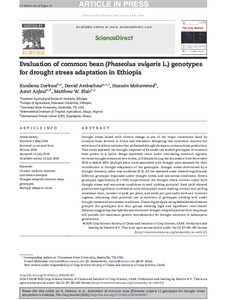| dc.contributor.author | Darkwa, K. |
| dc.contributor.author | Ambachew, D. |
| dc.contributor.author | Mohammed, H. |
| dc.contributor.author | Asfaw, A. |
| dc.contributor.author | Blair, M.W. |
| dc.date.accessioned | 2019-12-04T11:03:52Z |
| dc.date.available | 2019-12-04T11:03:52Z |
| dc.date.issued | 2016-07-22 |
| dc.identifier.citation | Darkwa, K., Ambachew, D., Mohammed, H., Asfaw, A. & Blair, M.W. (2016). Evaluation of common bean (Phaseolus vulgaris L.) genotypes for drought stress adaptation in Ethiopia. The Crop Journal, 1-10 |
| dc.identifier.issn | 2214-5141 |
| dc.identifier.uri | https://hdl.handle.net/20.500.12478/1262 |
| dc.description | Open Access Journal, Article In Press |
| dc.description.abstract | Drought stress linked with climate change is one of the major constraints faced by common bean farmers in Africa and elsewhere. Mitigating this constraint requires the selection of resilient varieties that withstand drought threats to common bean production. This study assessed the drought response of 64 small red-seeded genotypes of common bean grown in a lattice design replicated twice under contrasting moisture regimes, terminal drought stress and non-stress, in Ethiopia during the dry season from November 2014 to March 2015. Multiple plant traits associated with drought were assessed for their contribution to drought adaptation of the genotypes. Drought stress determined by a drought intensity index was moderate (0.3). All the assessed traits showed significantly different genotypic responses under drought stress and non-stress conditions. Eleven genotypes significantly (P ≤ 0.05) outperformed the drought check cultivar under both drought stress and non-stress conditions in seed yielding potential. Seed yield showed positive and significant correlations with chlorophyll meter reading, vertical root pulling resistance force, number of pods per plant, and seeds per pod under both soil moisture regimes, indicating their potential use in selection of genotypes yielding well under drought stress and non-stress conditions. Clustering analysis using Mahalanobis distance grouped the genotypes into four groups showing high and significant inter-cluster distance, suggesting that hybridization between drought-adapted parents from the groups will provide the maximum genetic recombination for drought tolerance in subsequent generations. |
| dc.description.sponsorship | CGIAR Generation Challenge Program |
| dc.description.sponsorship | Bill & Melinda Gates Foundation |
| dc.description.sponsorship | Evans Allen Fund |
| dc.format.extent | 1-10 |
| dc.language.iso | en |
| dc.subject | Genotypes |
| dc.subject | Bean |
| dc.subject | Grain Legumes |
| dc.subject | Phaseolus Vulgaris |
| dc.title | Evaluation of common bean (Phaseolus vulgaris L.) genotypes for drought stress adaptation in Ethiopia |
| dc.type | Journal Article |
| dc.description.version | Peer Review |
| cg.contributor.crp | Genebanks |
| cg.contributor.crp | Grain Legumes |
| cg.contributor.affiliation | International Potato Center |
| cg.contributor.affiliation | Hawassa University |
| cg.contributor.affiliation | Southern Agricultural Research Institute, Ethiopia |
| cg.contributor.affiliation | Tennessee State University |
| cg.contributor.affiliation | International Institute of Tropical Agriculture |
| cg.coverage.region | Africa |
| cg.coverage.region | East Africa |
| cg.coverage.country | Ethiopia |
| cg.authorship.types | CGIAR and developing country institute |
| cg.iitasubject | Genetic Improvement |
| cg.iitasubject | Grain Legumes |
| cg.journal | The Crop Journal |
| cg.howpublished | Formally Published |
| cg.accessibilitystatus | Open Access |
| local.dspaceid | 78665 |
| cg.targetaudience | Scientists |
| cg.identifier.doi | https://dx.doi.org/10.1016/j.cj.2016.06.007 |

